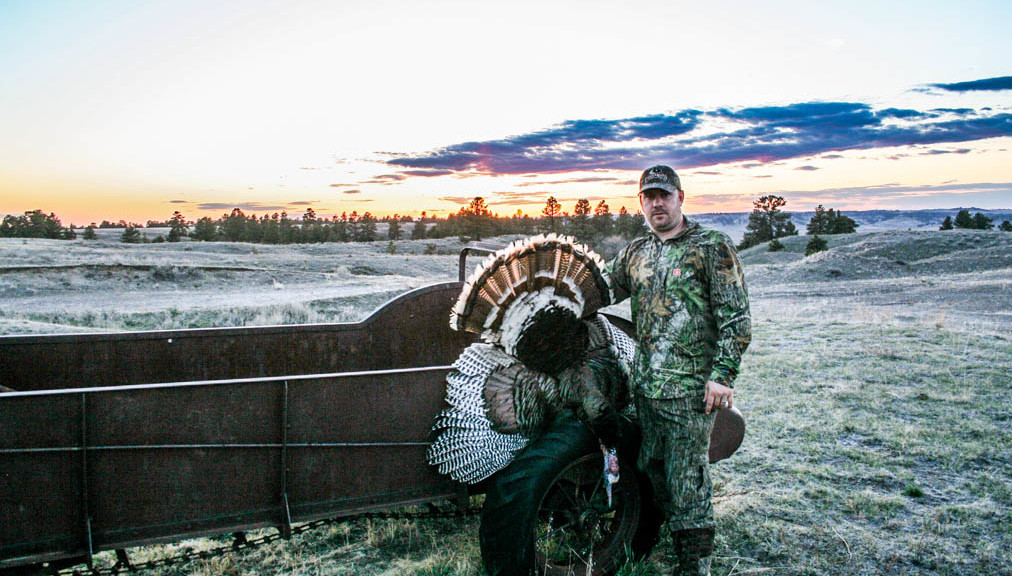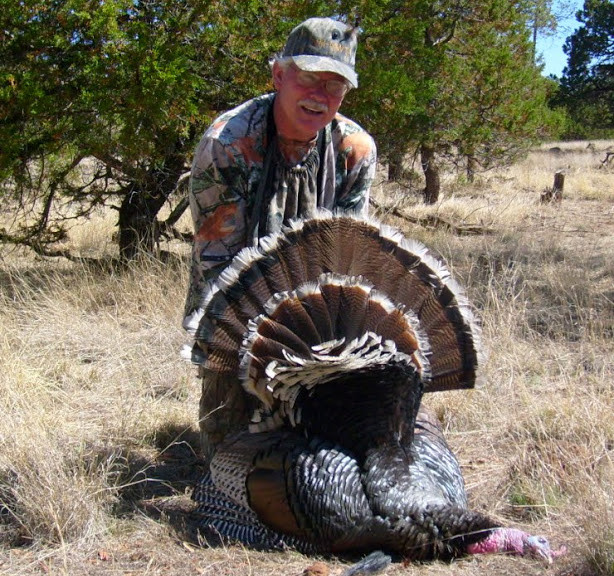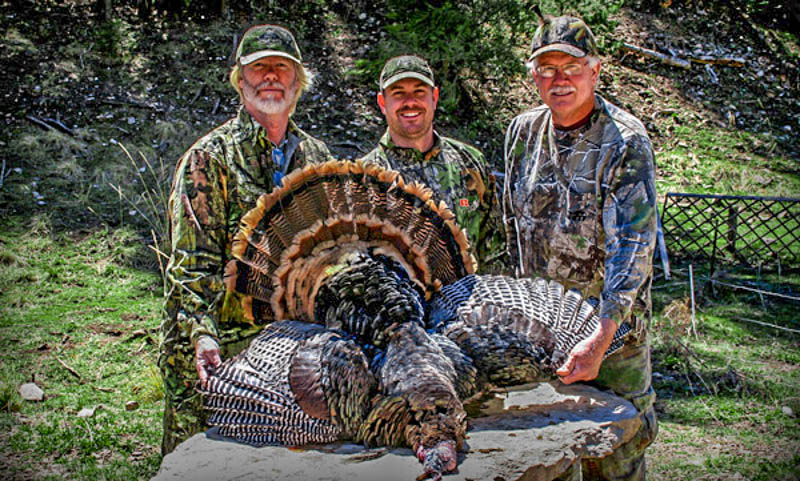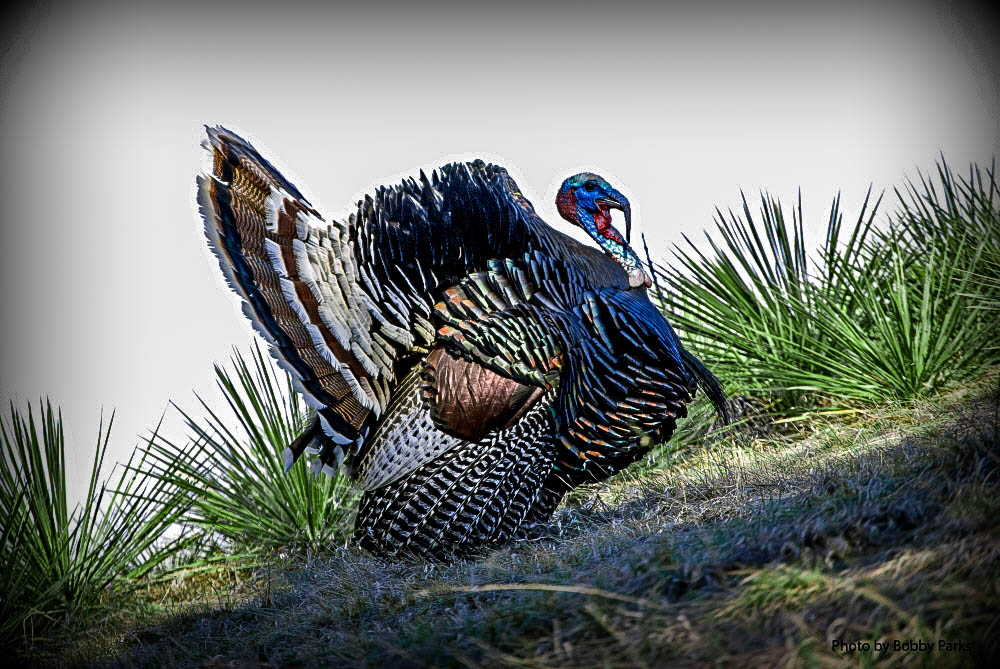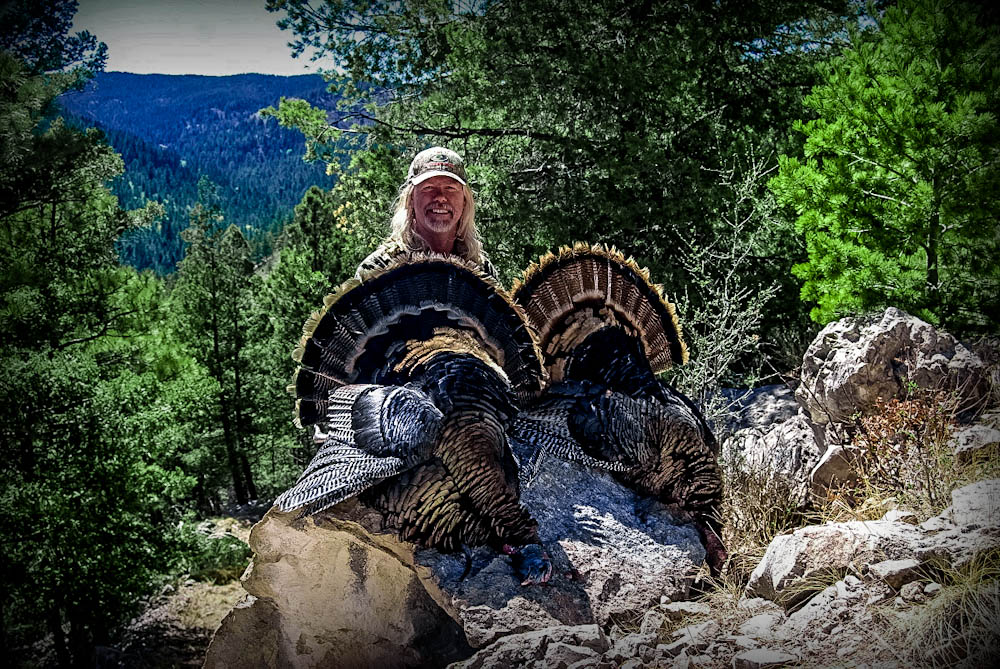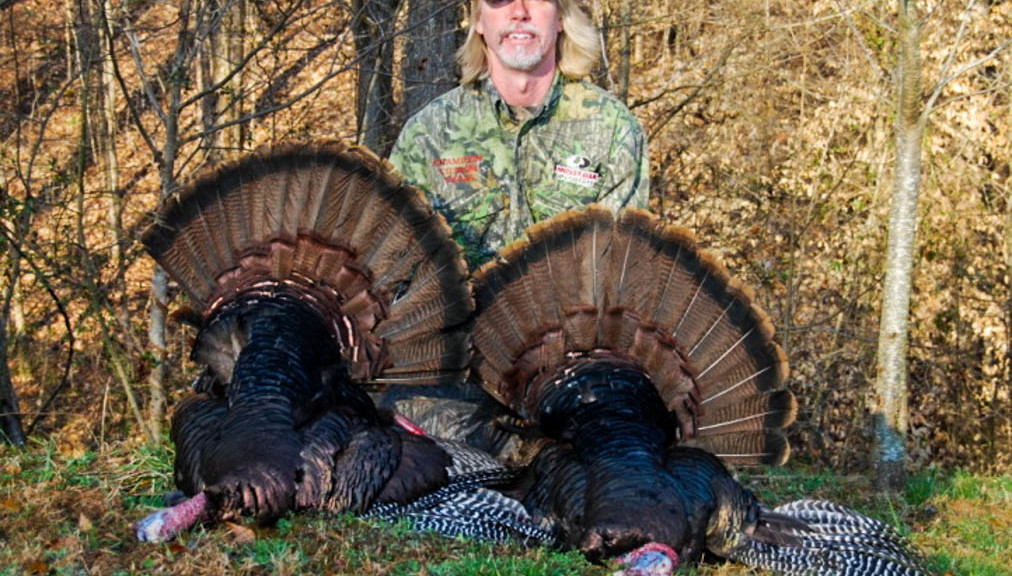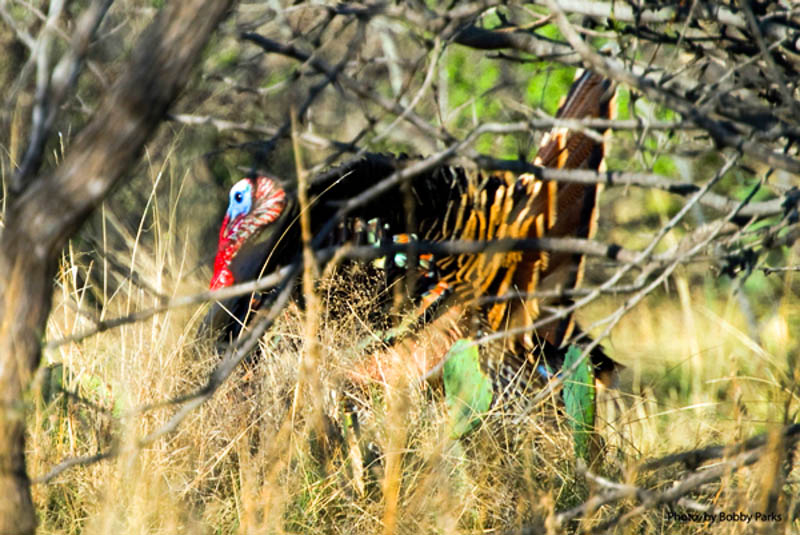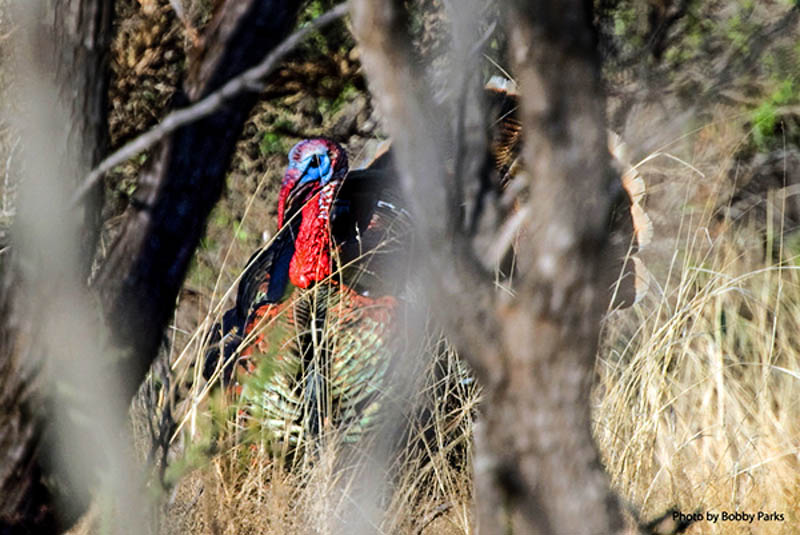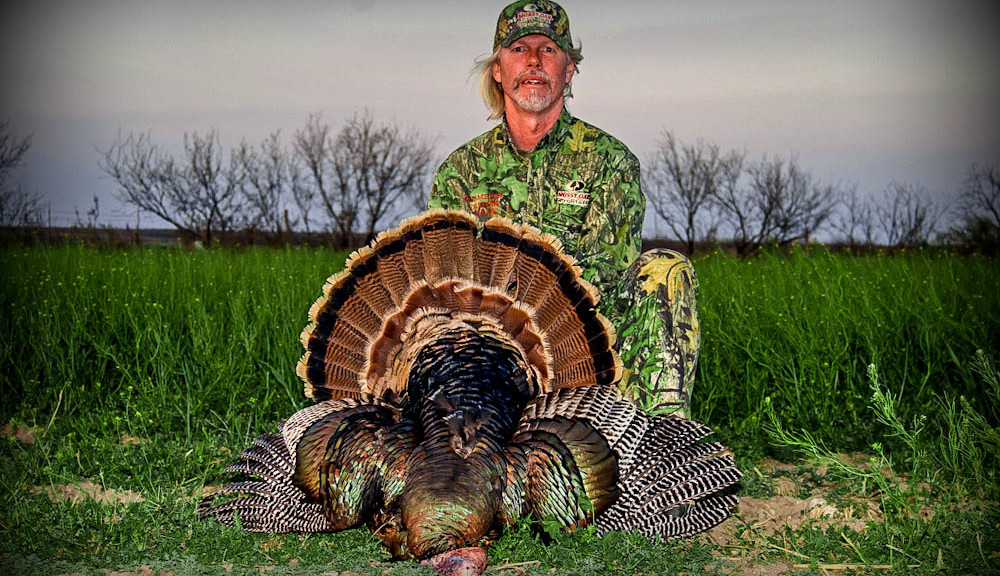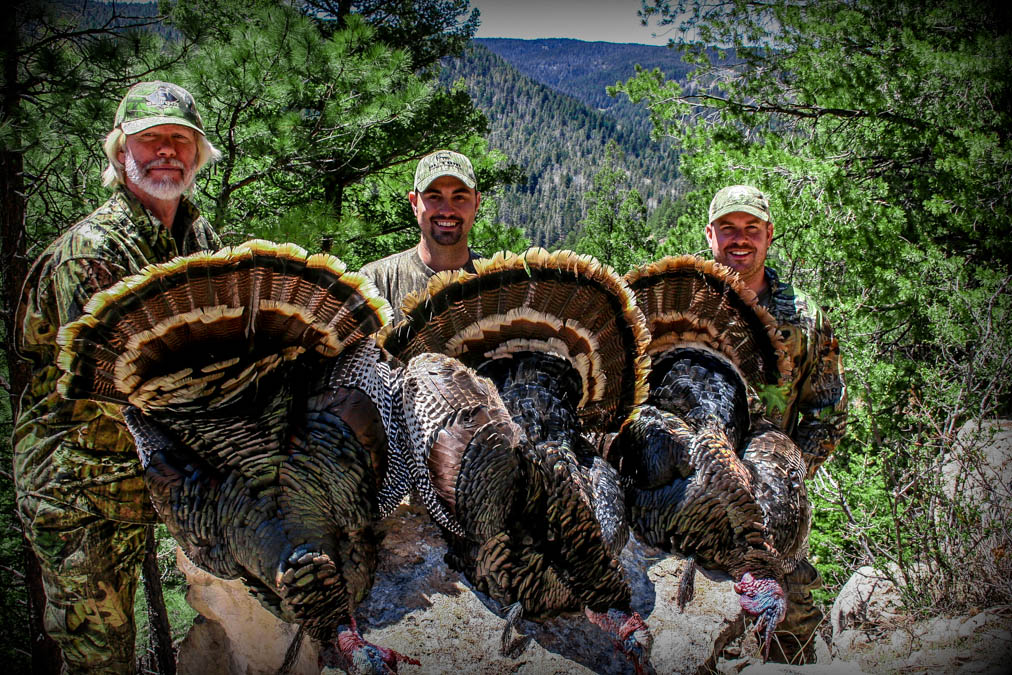Jim Bates resides in Las Cruces New Mexico and has been involved with the NWTF and with the state of New Mexico’s conservation efforts for many years. I met Jim 3 years ago and I can tell you he is as unselfish and humble as the day is long and it took me a year of knowing him before I even found out about this bird. The Grand Slam Network asked Jim Bates to share his story about the hunt involving his taking of the World Record Goulds turkey. It took some prying on our part as Jim is one of those guys who never wants to appear as though he’s bragging about anything. Well this is something to brag about and fortunately for us, Jim is a very good writer as well as turkey hunter. The following is his story regarding this once in a lifetime hunt.
Bobby Parks
Ocho Barvas by Jim Bates
“Shoot him, Dennis!” I whispered to my hunting companion who sat next to me under the scraggly juniper tree we had chosen for our blind.
“No…you shoot him!”
“Dennis, shoot him…he’s got at least three beards!” I emphasized as the big gobbler walked casually by us five yards away.
“No…he’s your bird, shoot him! Dennis retorted as the distance between us and the bird gradually widened.
“It’s your turn; I shot the last bird yesterday!” I hissed.
“He’s walkin’ off, you better shoot him!” Dennis responded, matter-of-factly.
Such was our animated exchange as we slowly watched the Goulds gobbler walk out of sight up the canyon, and presumably, out of our lives forever.
“I can’t believe you didn’t shoot that bird! Did you see how big he was!…how many beards he had!” I scolded Dennis as we both sat there in utter disbelief, recognizing that we had just bickered our way out of the bird of a lifetime for one of us. Disbelief soon turned to laughter as we both shook our heads and chided each other over what we had just done.
That whole episode and what had transpired on this morning and the two days before, were a result of a series of events caused by our association with the National Wild Turkey Federation. Until five years prior to this adventure, Dennis Daniel and I had never laid eyes on one another, had never spoken, and likely never would have except for our respective positions with the NWTF. You see, at the time Dennis was working out of the NWTF headquarters in Edgefield as the Making Tracks coordinator with the Forest Service, and I was serving an extended term as the New Mexico State chapter president.
The two of us had become acquainted when we met at a NWTF regional biologist’s meeting held in New Mexico’s Lincoln National Forest several years prior. As is generally the case in these situations, our initial conversations had eventually turned to hunting as Dennis and I, along with other attendees at the meeting, discussed the possibilities to be found in the mountains and forests of New Mexico, as well as the respective locales from which each of us had come. In the next several years, Dennis and I would run into each other at NWTF meetings and events on occasion, or find ourselves chatting about NWTF or Forest Service issues via e-mail.
Ultimately, our conversations would invariably lead back to hunting. Dennis and I found we shared common hunting interests, not only with wild turkeys, but also with elk, and soon we found ourselves contemplating hunts for both. The spring of 2005 found us hunting together in Florida for the Osceola subspecies, and again in the fall, when we got together for an elk hunt in New Mexico. During that hunt, we discussed the possibilities of an excursion into Mexico to hunt Gould’s gobblers. I had mentioned to Dennis previously that I had been attempting to make contacts in Mexico to set up some spring hunts, and that a hunt for the spring of ’06 was beginning to look promising.
“Count me in if it comes together”, Dennis said.
“Okay, you’re on my short list” I assured him.
As time went by, the possibilities of a Gould’s hunt became more promising. Numerous obstacles that had looked almost insurmountable at one time or another slowly began to fall by the wayside. One by one, issues and concerns were addressed. Arrangements were made with my contacts to procure the necessary licenses and permits. Access to a property that had Goulds turkeys was obtained. Shotguns for the hunt were gathered up by our Mexican contacts so that we would not have to deal with trying to jump through all of the hoops needed to take our own shotguns. Insurance and registration concerns about taking vehicles into Mexico were explored. By the end of March, I felt fairly confident that our “do it yourself” Goulds hunt was going to come together. From that point forward, Dennis and I referred to our hunt as “the great adventure”.
And so, on May 3rd, I picked up Dennis at the El Paso International Airport, both of us anxious to see how things were going to work out. After gathering up food and provisions for our journey south, and confirming plans with the other two individuals who were to be part of our group, we went to bed that evening believing that we had covered all the bases and were ready to go.
At dawn on May 4th, the four of us departed Las Cruces, Dennis and I in my 4X4 pickup and the others in theirs. The first bump in the road occurred when we tried to cross the border. Dennis and I had all of our paperwork in order, and had no problem getting the necessary permits for ourselves and my vehicle. However, our companions, it turned out, did not have all of their “ducks in a row” in terms of paperwork on their truck, even though we had discussed and cussed the details “ad nauseum” for weeks before the hunt. To make a long story short, the two of us were allowed into Mexico, and the other two were turned back. I insisted that they try to get things straightened out and try to come down to meet us later but after all was said and done, they could not.
We were scheduled to meet our Mexican contacts before noon, so Dennis and I headed south toward Chihuahua City. After a three-hour drive, we met Jeremy, the owner of the property we were to hunt, at an intersection of two highways, and after waiting for the arrival of our two assigned guides, Pedro and Carlos, we headed west towards the Sierra Madres. By mid-afternoon, we had made our way through one mountain range, across a high plain, and into the next mountain range, which comprised the ranch we were to hunt, and which supposedly held an abundance of our quarry.
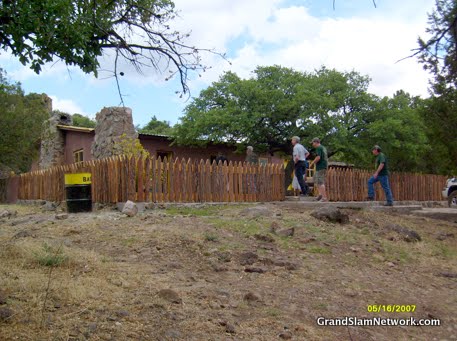
Upon arrival at our destination, a neat little Mexican ranch nestled in a small canyon at the base of the mountain range, we were shown our quarters and given a brief rundown on the facility and the hunt. I had been told, in my initial contacts with the outfitter, that the ranch was about 9800 acres in size. After questioning Jeremy about the size of the property, his first response was “who told you that?” Expecting “ranch shrinkage” to occur at this point in time, imagine our delight when he informed us that his place was almost 50,000 acres! And not only that, but the turkeys, of which he assured us there were many, had not been hunted in at least five years that he knew of!
So here we were, the two of us, hunting a huge Mexican ranch on which the current generation of Gould’s turkeys had never been harassed by hunters! We looked at each other with sly smiles which essentially conveyed the meaning: “What a Deal!!” Needless to say, our optimism for the possibilities for “our adventure” was sky-high!
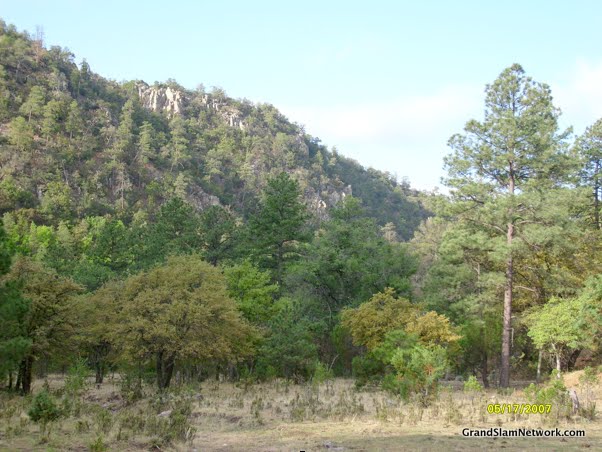
That afternoon, that optimism was rewarded when our hosts drove us higher into the rugged mountains to a rock dam on the edge of a high mesa. We parked the truck and eased our way to within a couple hundred yards of the dam, and there, in a sun-drenched clearing, were perhaps two dozen Gould’s turkeys, gobblers and hens, going about their business. As we sat and watched the birds—we had chosen not to take guns on this first afternoon reconnaissance mission—-we marveled at the size of the strutting gobblers and their glistening white fans and rump feathers. There were at least eight mature toms in this procession, and even though it was late afternoon when gobblers are generally prone to be somewhat hush-mouthed, these birds were whoopin’ it up. Gobbles rang out with regularity, and Dennis and I just looked at each other and gleamed. It was beginning to look more and more like this adventure was going to be a doozy!
That evening, over a mesquite-grilled steak dinner, we discussed our plans for the next morning with our hosts. We would return to the rock dam on the mesa before daylight and head for the first gobbles, wherever they might be. After inspecting the five shotguns that our hosts had rounded up, all 12 gauges of various persuasions and chokes, we settled on a Beretta semi-auto and a Remington pump as our weapons of choice for the next morning.
At first light, we found ourselves standing in the pre-dawn darkness in the clearing next to the dam. We were somewhat surprised when it was nearly full daylight before the first gobbler sounded off in a deep canyon immediately to the south of the dam. We hiked to the edge of the canyon, and soon we could see him strutting on a shale rockslide near the canyon bottom 500 yards away. We briefly contemplated attempting to find a way off of the precipice and into the chasm, but eventually came to our senses and decided instead to bide our time in the vicinity of the dam. Finally, after another half-hour, we were rewarded with distant gobbling on the mesa a few hundred yards to the west. Our entourage of four moved quickly in the direction of the gobbler, which, we were fairly certain, was now on the ground and readying himself for the morning’s courtships.
We moved through the scattered oaks, junipers, pinons, and manzanita until we thought we were within striking distance. Dennis and our two assistants crawled up under the low branches of a small juniper tree while I hurriedly looked for a suitable spot to try to film the action with my video camera. After all of us were satisfied with the set-up, Dennis enticed the bird with a soft series of yelps. From that direction came a responding gobble. All was well. A couple minutes later Dennis once again called to the gobbler but this time received no response in return.
I was busily trying to pan the area to get some set-up footage for the hunt. As I panned to the left and out in front of us, something looked out of place. Closer inspection revealed a lone mature gobbler, standing at the base of a pinon tree forty yards distant. The bird had quietly moved in and was now surveying the situation. Soon he ballooned into full strut, and began what would turn out to be an excruciatingly long performance within a five yard radius of that pinon tree. Not knowing how the Beretta would perform at that distance, Dennis chose to bide his time and hope that the big gobbler would eventually venture closer. Such was not the case however, as the bird had set up shop and was not about to sully his reputation by advancing further toward this apparently irreverent hen.
As time slowly slipped by, I was beginning to wonder if we had reached an impasse with the bird. He would not take a step closer than about forty yards, and try as we might, we could not entice him to come further. At about the forty-five minute mark of what was now turning into quite an ordeal, since both of my legs had fallen asleep and my back was screaming for some Doan’s pills, I thought I heard faint drumming from behind us. As the sound grew closer and more distinct, it soon was apparent that another gobbler was approaching from our backside.
This gobbler’s approach was slow and calculated as well, but soon I could see the bird swinging around the far side of the tree under which Dennis and our two amigos sat, and I swung the camera around just as the bird passed by them at about ten yards. As I filmed, the tom headed directly toward the other gobbler, and at fifteen yards, Dennis raised his gun and ended the suspense of this opening act of our hunt.
His first Gould’s gobbler under his belt, which incidentally completed his royal slam, Dennis was all smiles as we admired the beautiful tom. After the obligatory back-slapping, picture-taking, and story re-hashing, we continued on with the hunt in an effort to find another bird for me, and although we heard a few more gobblers and tried a couple of set-ups, the big birds were content to go about their morning without indulging us.
Later that afternoon, after eating a late breakfast at the ranch and taking care of the processing of Dennis’ gobbler, we decided to once again head back to the rock dam to try to find me a bird. It was basically a repeat of the first afternoon in that we approached the dam and found several turkeys, including at least four adult toms, hanging out there. Moving as close as we could without being detected, I got out in front of our quartet and called to the birds.
The brush was fairly thick in the area of our set-up, which ultimately led to me not noticing the first pair of gobblers that eased by to our left at about forty yards. As they moved away from us, I chastised myself for not being attentive enough. However, Dennis motioned to me that another gobbler was approaching on the far side of a juniper tree that obscured my vision. I scooted slightly to my left to see around the tree, and immediately could see not one, but two gobblers slinking through the brush at twenty yards, skirting to my left.
They were not aware of our presence, and a couple of soft yelps on a mouth call, brought them out into the open at fifteen yards. Both were good, mature gobblers, and I shouldered the same Beretta that Dennis had used to dispatch his bird that morning and placed the bead on the head of what I thought was the larger of the two. At the shot, the birds (yes, that’s right… birds) startled and began running for cover. In a momentary state of shock over having missed the tom at no more than fifteen yards, I barely recovered in time to roll him with a second shot before he could dart into the brush.
I was relieved that I had managed to cleanly kill the bird with the second shot, which had I not done would surely have meant an endless barrage of needling from Dennis, not to mention the two guides. Any such badgering, I’m sure, would have continued non-stop for the remainder of the trip (and in Dennis’ case, for the remainder of our association). We gathered up the bird and proceeded with another round of congratulations, pictures, and hunt summaries.
Needless to say, Dennis and I were in good spirits that evening, especially after our successful negotiation of an agreement with our compadres to hunt for a second bird apiece. With a plan in place to hunt a new area of the ranch on the second day, we enjoyed the evening, along with our new friends, over grilled country ribs and a number of cold beverages.
The next morning found us in the situation described at the beginning of this article. Pedro and Carlos had taken us to another known roosting area in the bottom of one of the major canyons on the ranch and at daybreak we had several gobblers within earshot. The first bird to come to our calls was the big old boy that we inexplicably, and apparently with a full dose of turkey hunter’s irrationality, let walk away unscathed.
After mutual admonishment for what we had done, we continued to call from the same location for another hour. Two other mature gobblers came to investigate during that time, but neither was exceptional, or at least not in the same class as the first bird. We could hear hens yelping, and occasional gobbling, up the canyon bottom we were in, so after concluding that we had milked our stand for as much action as it was going to give us, we got up and gathered up Pedro and Carlos from the brush behind us. By this time, we had made the two of them the designated hunt videographers, and they were enjoying trying to get good video footage of these two American buffoons who had just let “guajolote macho grande” (REALLY big gobbler) walk off.
Easing up the canyon bottom toward the still-very-vocal group of Gould’s turkeys, we approached as closely as we thought we should. There were two good-sized Chihuahuan pine trees nearby, and we agreed that we would just stand against the two of them and call to the birds to see what developed. Our two movie-makers ducked into the brush behind us as we sent forth a few inquiring yelps. Immediately, at least two hens on the slope above us responded, and soon we were in a four-way conversation with them. They would respond to every call we made, although the gobblers that were presumably with them would not, and we were finding ourselves quite entertained by the whole exchange, so much so that we failed to notice a big lone gobbler coming down the canyon bottom toward us. Fortunately, Carlos saw him, and whispered to let us know of his approach.
By the time Dennis and I noticed the bird, he was forty yards out and on a steady march to locate these two new noisy hens. As he closed the distance, I heard Dennis whisper, “Jim, I think it’s that same gobbler!”
“Are you sure?” I asked, not yet being able to see the bird’s chest well.
“Yeah, it’s him….shoot him!”
“YOU shoot him!” I whispered emphatically, while at the same time thinking to myself, “Oh no, here we go again”.
“No, I want YOU to shoot him!”
“Dennis, we’re not going to let that bird walk away again…SHOOT HIM!” I demanded, the gobbler by now walking past us at fifteen yards, and obviously becoming concerned about the two talking tree trunks.
“I don’t have a shell in my gun!” Dennis whispered with a smirk, content that this probably intentional oversight would finally settle the issue. “YOU are going to have to shoot him!”
Realizing that Dennis had played the final trump card, and that it was time to throw in the towel, I raised the shotgun, brought it up and around the tree I was behind in one motion, settled on the gobbler’s head, and ended the discussion once and for all.
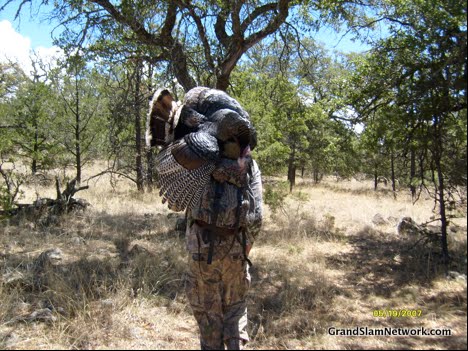
Whoops and hollers followed, as the four of us ran to the gobbler, all anxious to see just what this grand bird had to show us. When things had finally settled down, I gently turned the bird over and fumbled through his breast feathers to sort out the assortment of “modified feathers” which adorned his chest. The first count was five beards, the second came up with seven, and the final tally, after I had settled down enough to actually think rationally and do a systematic inspection, was eight.
“Ocho barvas!! Ocho barvas!!” Pedro and Carlos exclaimed in unison, recounting the total in Spanish. Before us lay the granddaddy of all Gould’s gobblers. Looking down at his legs, we were equally delighted that he had good spurs, by Gould’s standards, on both legs, somewhat of a rarity in itself. All in all, he was, without a doubt, the bird of a lifetime…. and to think that the two of us had almost let him walk off TWICE!!
That evening, two hours before dark, we again returned to the rock dam in an attempt to fill Dennis’ second tag. As was the case the previous two afternoons, there were several gobblers in the area, and Dennis tagged his second gobbler, another exceptional bird, if only having ONE ten-inch beard, after a classic calling session that brought the bird, and another, in strutting and gobbling.
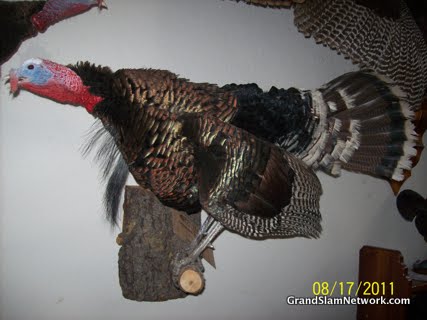
All told, the two of us had taken four outstanding Gould’s gobblers in two days, had an absolute blast, and had made a number of new friends from a different nation in the process. For two would-be strangers from opposite ends of the country, who had only met as a result of a mutual association with the National Wild Turkey Federation, the adventure did indeed turn out to be BIG!!
FOOTNOTE: After all was said and done, I was curious to see just how well Ocho Barvas would stand up against other Gould’s gobblers in the NWTF record book. After reviewing the record book and the scoring system, I was surprised to find that he is the new atypical record for Gould’s scoring 139.00 and besting the old record by somewhere in the vicinity of 23 points! He has eight beards with 52.5” of total beard length (longest 11 1/8”), has spurs measuring an average of ¾” each, and weighed an even 19 lbs.
If you go…
As turkey hunting increases in popularity across the country, more and more hunters are becoming interested in traveling to Mexico to hunt the fifth of the North American subspecies, the Gould’s, in an effort to complete their “royal slam”. Although we went to great lengths to try to avoid any pitfalls with our trip, we did encounter some stumbling blocks along the way. From my experience, it appears that the rules and regulations are subject to interpretation, depending on what port of entry is used to cross back and forth into Mexico. Hunters who plan hunting trips into Mexico should be aware of the following:
1) Make sure you have acquired a passport (a birth certificate and drivers license or I.D. will no longer be acceptable beginning in 2008), and make sure you get your passport properly stamped when entering and exiting Mexico. Not getting the proper stamps on your passport when you depart Mexico could result in complications if you were to try to re-enter at a later time. There will generally be a nominal fee associated with your entry into Mexico for your hunt.
2) If you take your own vehicle into Mexico, make sure you arrange for supplemental insurance on it for the time you will be down there (you can contact your insurance agent for information on this—the cost for five days of full coverage for my pick-up was about $75.00 American). You also must have the vehicle registration (current) with you and proof of insurance coverage on the vehicle. You will be issued a vehicle permit at the Mexican port of entry. (The cost for this permit for our five day stay was about $30.00). You must relinquish this permit when you leave the country.
3) If your vehicle has a lien holder, you should contact them and ask for a letter of permission to take the vehicle into Mexico. Although I was not asked to present this document, I have been told that it is best to have it available just in case, as you may be denied entry if you don’t have one and are asked to show it.
4) While in Mexico, you most likely will be able to pay for things with American dollars, and in many cases this will be preferred. Make sure you take small denominations with you to pay for incidentals like food, gas, and tolls and become familiar with the currency exchange rate between Mexican pesos and American dollars. Many vendors/stores will take American credit cards, as well, but don’t depend on paying for things with them.
5) Make sure the Mexican outfitter you deal with can provide you with all of the licenses, permits, and documents that you will need (and don’t assume that he knows about everything you are supposed to have—make sure you review the documentation needed and go over it with him). You must have a signed contract with the outfitter that outlines the details of the hunt and the ranch you are hunting. You also must have an official certificate with state seal (UMA hunting permit) from the Mexican state you are hunting that verifies you are hunting on a property that has filed for and met all of the hunt management criteria as required by the state. The outfitter should provide you with a numbered tag for each bird you kill (cintillo) and the tag number should be recorded on the contract. You must attach a validated, numbered tag to each bird you harvest. We were told by the field officers at U.S. Customs that it is a common problem to have hunters coming back from Mexico without all of the licensing and proper documentation that is needed.
6) Unless you have gone through all of the registration and licensing process to take your own guns for your hunt, make sure you do not have any firearms or ammunition with you when you enter Mexico. Having any kind of firearm or ammunition that is not properly licensed and registered will most likely bring a sudden and unpleasant end to your Mexican adventure and will probably result in you and your hunting party ending up in a Mexican jail. If you are relying on your Mexican outfitter to provide shotguns for your hunt, be certain that you and he have ironed-out all of those details.
7) At this time, you may bring the meat and of the turkeys you harvest back into the U.S. if you desire (We gave all of the meat from our birds to the ranch hands and our guides). Also, you may bring the capes of the birds and they should be packaged in a sealable container or bag (we put ours inside heavy duty trash bags and then put the bags in an ice chest. All capes are required to be sent to a certified taxidermist to go through a fumigation/delousing process before the bird can be mounted. You should obtain a list of the certified taxidermists from U.S. Customs (or your hunt booking agent, if you have one) prior to your trip, contact that taxidermist to confirm your intent to use his services for the process, and obtain the required form (Report of Entry/Shipment of Restricted Animal Products) for this. This document, which indicates where the birds will be sent to be processed, must be presented to U.S. Customs when you cross back into the United States.
8) Along with the above, a declaration form (Declaration of Importation of Wildlife) must be filled out and presented to Customs, as well. This document lists the numbers and the species that you are declaring to bring back across the border.
Also, regarding taking your own vehicle down for your hunt, you should be prepared for extremely rough travel on terrible roads through very rugged country. A four-wheel-drive vehicle is advised, preferably with high clearance, and don’t go down there without at least two spare tires, some “flat fix” cans, and a plug kit. And make sure your vehicle is in good running condition!
Finally, the people down in Mexico in general are very friendly, even though you may not be able to communicate fully with them. If you go down there with the proper attitude of respect for the Mexican culture and the people, you will undoubtedly have a wonderful experience and come back having made some very good friends.
By Jim Bates
